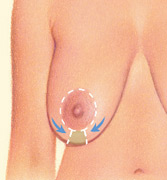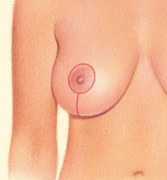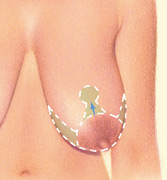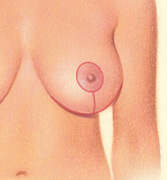Lewis Plastic Surgery: Gordon Lewis, MD
2331-A Robious Station Circle
Midlothian, VA 23113
(804) 267-6009
Monday–Friday: 8:30 a.m.–4:45 p.m.

Breast Reduction
Women at our Richmond, VA, practice who get breast reduction surgery often say it is a life-changing procedure after years of suffering both physically and emotionally. Patients say they are more physically active and self-confident after undergoing breast reduction surgery and enjoy wearing more stylish clothes that didn't fit well before the operation.
While countless women wish for larger, more voluminous breasts, others suffer from a condition called hypertrophy (abnormally large breasts). For these patients, we offer breast reduction surgery that not only enhances the bustline and balances body proportions, but can also alleviate a number of uncomfortable medical conditions caused by abnormally large breasts including;
- Shoulder pain
- Neck pain
- Back pain
- Skin irritation
- Asymmetry
In severe cases, extremely large breasts can lead to breathing difficulties and skeletal deformities.
Procedure
The most common types of breast reduction incisions
There are two main options for incisions. In both cases these incisions fade greatly over time and, although present, are usually not very evident after fully healed.


Lollipop Incision
The lollipop incision is a great way to limit the scars in smaller breast reductions. This incision pattern has an incision around the nipple and downward to the infra-mammary fold. This eliminates the incision running horizontally underneath the breast. Unfortunately, not all women are candidates for this incision pattern. It does not allow for as much skin removal as the anchor incision and therefore is not a great choice in larger reductions.
A ‘lollipop’ incision around the areola and vertically down to the breast crease.


Anchor Incision
This incision is the most common incision for breast reductions. This includes an incision around the nipple, extending downward to the inframammary fold, and also across underneath the breast. This incision pattern is the best at addressing the extra skin associated with larger breasts. It allows the greatest removal of skin, which facilitates the greatest improvement in shape. Most breast reductions covered through an insurance policy have a minimum amount of breast tissue to remove. This is usually a relatively high quantity and requires a fairly large amount of skin removal to obtain balance and achieve a natural look.
Raising the nipple to a youthful position
In all breast reductions the nipple is raised to a higher and more youthful position on the breast. The breast is narrowed and the breast is raised on the chest wall to a higher position. The incisions will depend on each patient’s specific anatomy. In smaller patients with less tissue to remove, the incision will be a “lollipop” incision around the nipple and down to the base of the breast. In larger reductions, where more skin needs to be removed, the planning also requires an incision across the base of the breast, “inverted T” or “anchor” incision. A pre-determined amount of tissue and skin are also removed and the nipples are repositioned. If required, excess fat is removed using a liposuction technique.
Differences in the types of breast reduction available
There are two main types of breast reductions, and one less common type. The types are based on the location of the tissue (including blood supply and nerves) that is left in place underneath the nipple.
Superio-medial pedicle
Dr. Lewis performs nearly all of his breast reductions using this newer technique (also called the “vertical” breast reduction). This technique keeps tissue from above and medial of the nipple to support the nipple and areola after the operation. This allows breast tissue to heal to breast tissue on the bottom of the breast. The benefits are that the blood supply to the nipple is better and the risk to the nipple is less. There is less issue with poor healing of the incisions, and this technique has less long term sagginess to the breasts. This incision allows the small lollipop style incisions.
Inferior pedicle
In this method, a band of tissue from the bottom of the breast supports the nipple. This band of tissue is generally longer, and therefore has less blood supply to the nipple than the superior-medial technique. The inferior pedicle also has a much higher rate of poor healing of the incisions. Finally, after healed the overlying skin provides the strength to the shape of the breast. Unfortunately, this is not as strong as the breast tissue, and this technique is more likely to “bottom out” as the skin stretches. There are rare circumstances when this may be the better option. This type of breast reduction requires the anchor style incision.
Free nipple
This operation is reserved for a small percentage of women who have “very” long breasts. In this situation, the blood supply to the nipple after a breast reduction would be so reduced that the nipple could not survive. In this circumstance, the nipple is removed from the breast and replaced as a graft. This has several negative effects, and therefore is not a preferred option. We perform one to two of this type annually. The anchor style incision is used with this type of breast reduction.
Stop by Our Blog
This is your resource for what you really want to know about plastic surgery, nonsurgical cosmetic treatments, and our practice.
Read more here
Recovery
Will anesthesia or pain relief be used during and after surgery?
You will be made comfortable throughout the whole procedure. Most women have a general anesthesia for this surgery. However, if a patient has a medical condition or concern that would preclude general anesthesia, monitored sedation can be used. After surgery, you will be given instructions on pain relief medication, if required.
What happens immediately after surgery?
Following surgery, you will wear surgical dressings and have drains for about two to three days. The first post-surgery visit will be two to three days after surgery; the drains will be removed at that time. Swelling, soreness and discomfort may last up to a week. We provide you with prescription medicine to maximize comfort. You may also experience dry skin, mild discomfort during the first menstrual period following surgery and loss of nipple sensation, all of which resolves within a few weeks.
How long will complete recovery take?
Normally you will be able to return to work within 7-10 days, but will continue to see us for several weeks until final results are achieved. A full recovery and final results are generally achieved within six months once the breasts have settled into their new position.
Any medical condition associated with abnormally large breasts usually resolves right away. Most patients report no longer having back pain or skin irritation, and are able to sleep better and perform daily tasks as well as exercise after recovery.
Candidacy
Am I a good candidate for breast reduction surgery?
Yes, if you are a healthy individual seeking to find relief from the symptoms from large breasts.
It is important to note that while many teenage girls suffer from abnormally large breasts, breast reductions prior to full development may result in recurrence of the large breasts. In fully developed women, the breasts do not “come back” after a breast reduction. Of course, breast size and shape, after a reduction, will still vary with changes in overall weight, and change with pregnancy.
Risks
What are the risks of breast reduction surgery?
Check Accreditation
With any surgical procedure there are risks that you must be aware of. To minimize the risks, ensure your surgery is conducted in a safe and secure environment using the latest surgical techniques by checking the certifications and accreditation of your surgeon. Accreditation boards and bodies are there to protect you. Dr. Gordon Lewis has 9 years surgical experience and is affiliated to several important professional organizations.
- He is board certified by the American Society of Plastic Surgeons www.plasticsurgery.org
- Affiliated to the Richmond Academy of Medicine www.ramdocs.org and the Medical Society of Virginia www.msv.org
- He is also an associate member of the American Society for Aesthetic Plastic Surgery www.surgery.org and the American College of Surgeons www.facs.org
- A candidate member of the American Society for Surgery of the Hand www.assh.org
Possible Complications
During your initial consultation, we will discuss every possible outcome of your procedure including possible complications.
Although infrequent, breast reduction surgery risks may include (but are not limited to);
- Numbness
- Inability to breast feed
- Poor scar healing or infection
- Blood clots
- Swelling or bruising
- Excessive firmness of the breast
- Loss of nipple and or areola
It is important to note that the length of the surgical incisions and extent of scarring varies from one patient to another depending on the complexity of the procedure.
Consultation
At the time of the consultation, we will closely examine your breast anatomy and other factors such as amount of fat and tissue to be removed. We’ll discuss in detail your health history, medical conditions associated with abnormally large breasts and your aesthetic goals.
During this consultation you will learn more about:
- Breast size, shape and skin characteristics
- Amount of breast tissue and glandular fat to be removed
- Relocation and new shape of the nipples
- Breast reduction and aging
- Anesthesia and facility
- Cost of surgery and financing options
Location
Dr. Lewis performs surgical procedures at an accredited outpatient surgical center or a local hospital. He is affiliated with several local medical centers where his patients undergo surgery. He primarily operates at these locations:
Johnston-Willis Hospital
Stony Point Surgery Center
Initial consultations, follow up appointments and all non-surgical treatments and minor surgical procedures are performed at Lewis Plastic Surgery in Midlothian, VA.
Cost
Will breast reduction surgery be covered by insurance?
Dr. Lewis performs many breast reductions annually. The vast majority of these are covered under health insurance policies. Each health insurance company has different criteria to give authorization for breast reductions.; our office has become very adept at navigating this complex process and getting authorization for breast reduction. This is a procedure that insurance companies scrutinize heavily prior to giving authorization, but in most cases we are able to get approval for the surgery.
Booking
Every patient is required to attend an initial consultation before a procedure can be booked. Once you decide to proceed with surgery, we will assist you in finalizing a date and getting everything ready for surgery. We try to be as flexible as possible and will make arrangements to see you at Lewis Plastic Surgery in Midlothian within a few days after you contact us.
You can book a consultation online or by calling
(804) 267-6009.
Meet Dr. Gordon Lewis
Dr. Lewis, a native of Richmond, prioritizes building honest, trusting relationships and providing personalized care for his patients.
Meet Dr. Lewis







